Annie Kritcher: Tackling the Biggest Challenges
March 12, 2024
Before her senior year at the University of Michigan in 2004, Andrea “Annie” Kritcher seemed headed toward a career devoted to helping solve the biggest challenges in medical science. Then she joined Lawrence Livermore National Laboratory (LLNL) as a summer intern.
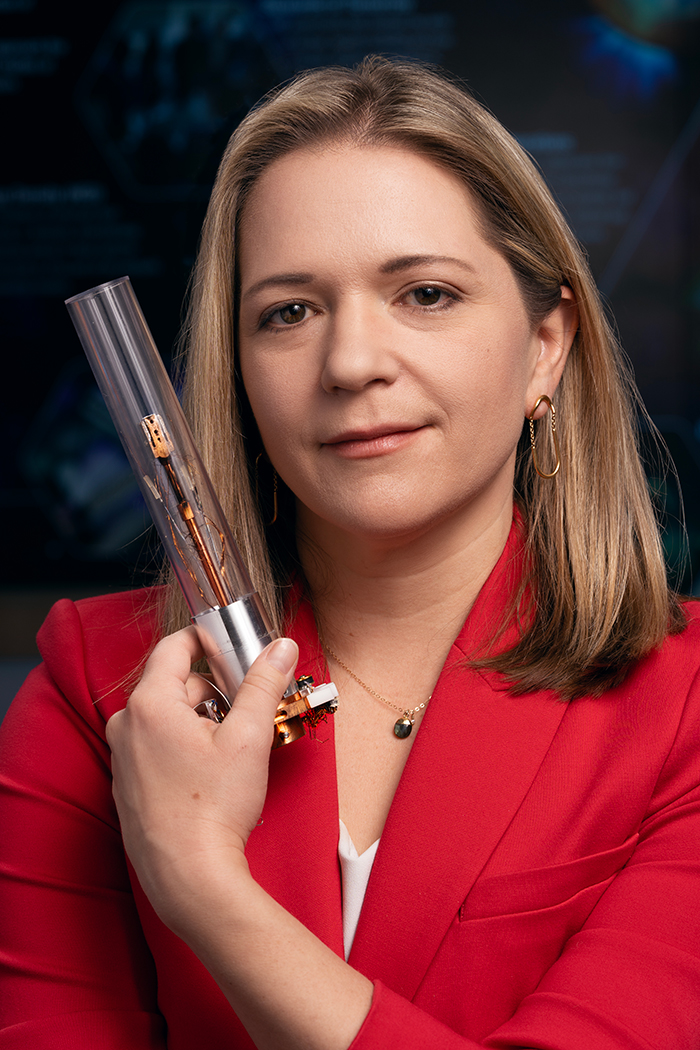 Annie Kritcher holds an ICF target like one used in LLNL’s historic December 2022 fusion ignition shot at NIF. Credit: Blaise Douros
Annie Kritcher holds an ICF target like one used in LLNL’s historic December 2022 fusion ignition shot at NIF. Credit: Blaise Douros “And then I saw NIF,” Kritcher says of LLNL’s National Ignition Facility. “That really sparked my passion for fusion. Plasma physics and fusion were always interesting to me. And the fact that we have the best facility to study inertial confinement fusion (ICF) in the United States was important.”
That first encounter with NIF sent the LLNL design physicist down a remarkable professional path. Two decades later, she has become widely known for her work on the experiment that accomplished a quest that she and thousands of others had worked on for decades.
Kritcher was the lead designer for the historic Dec. 5, 2022, experiment at NIF that achieved fusion ignition for the first time in a laboratory setting. She is part of a large multidisciplinary team, one of the 1,370 researchers from 44 international institutions who authored a peer-reviewed paper published in February in Physical Review Letters that detailed the scientific milestone.
She’s continued her work for four subsequent experiments that have repeated ignition.
Kritcher was drawn to the challenge because it wasn’t easy. And she’s always loved a challenge, whether it’s finding the perseverance to keep moving forward even when experiments don’t go as planned, or working out novel solutions that help maintain a healthy work-life balance as she and her husband raise three young children.
The bigger the challenge, the better. “I think that sums it up,” she says, “I’m kind of a challenge junkie.”
In the memorable year following the first ignition achievement, Kritcher has been thrust into the public spotlight with media interviews and attention-grabbing accolades. In April, Time named her to the news magazine’s annual list of the 100 most influential people in the world. And in December, the international science journal Nature named Kritcher one of the 10 people who helped shape science in 2023.
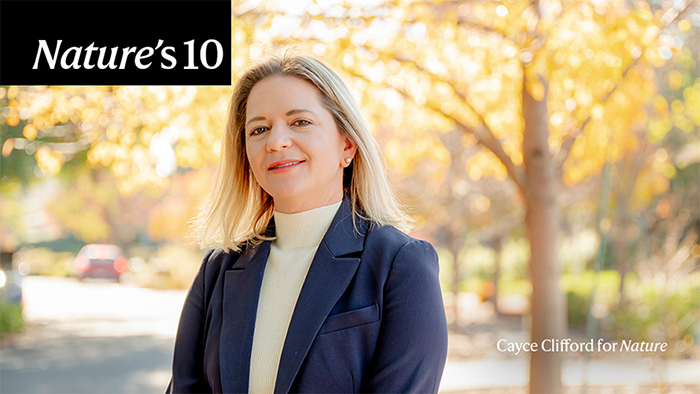 Nature named Kritcher one of the 10 people who helped shape science in 2023. Credit: Cayce Clifford/Nature
Nature named Kritcher one of the 10 people who helped shape science in 2023. Credit: Cayce Clifford/Nature 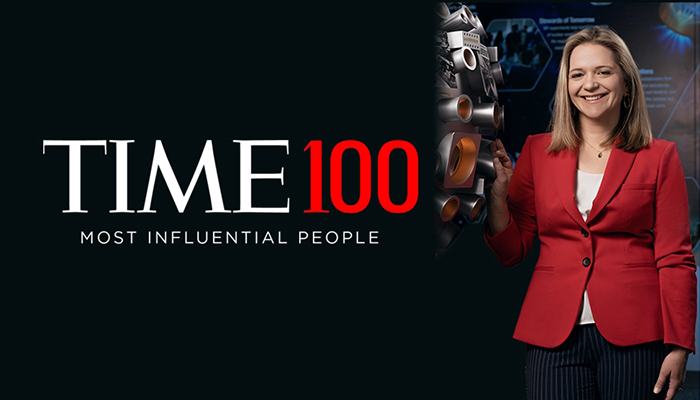 Kritcher was named one of TIME’s 100 most influential people. Credit: Blaise Douros
Kritcher was named one of TIME’s 100 most influential people. Credit: Blaise Douros The TIME100 designation was particularly mind-blowing for Kritcher. The self-described introvert felt “uncomfortable” getting the full red-carpet treatment at the magazine’s TIME100 gala in New York in April.
There she found herself chatting about fusion ignition with fellow high-profile TIME100 honorees like renowned author Judy Blume, who Kritcher called “one of the nicest and coolest people I met all night.”
And she met iconic journalist Katie Couric, the popular comedian Ali Wong, Airbnb CEO Brian Chesky, Salesforce CEO Marc Benioff, and award-winning actors Ke Huy Quan, Drew Barrymore, Austin Butler, and Jennifer Coolidge.
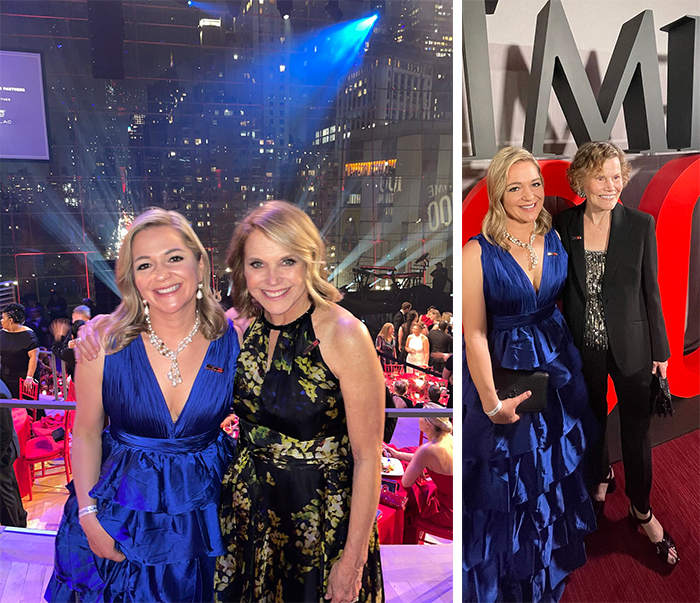 At the TIME100 gala, Kritcher met journalist Katie Couric (left) and author Judy Blume (right). Credit: Ying Wu
At the TIME100 gala, Kritcher met journalist Katie Couric (left) and author Judy Blume (right). Credit: Ying Wu “I’m mingling with CEOs of billion-dollar companies and celebrities, and so it’s just not a place I had envisioned myself to be in,” Kritcher says. “But then you start to realize everybody just wants the same thing and wants to look for ways to help the planet. And they were really interested and excited about fusion. That was a nice surprise to me because I didn’t understand how far-reaching that had become. So it was a cool experience.”
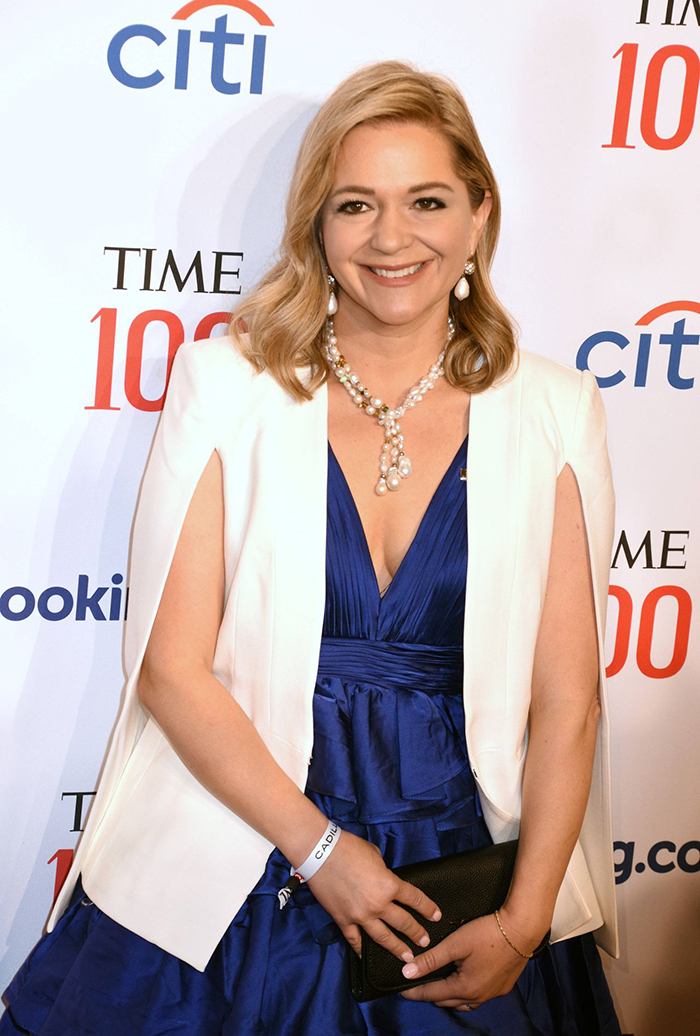 Kritcher poses on the TIME100 gala red carpet. Credit: Mpi099/Media Punch/Alamy Live News
Kritcher poses on the TIME100 gala red carpet. Credit: Mpi099/Media Punch/Alamy Live News Representing the Lab and her colleagues at such an event helped her find her comfort zone because she knows the importance of being able to communicate what the fusion ignition breakthrough means to the world.
“Getting the message out is so important that it kind of trumps my personality traits,” she says. “Being part of the TIME100 and getting that recognition for the Laboratory and for fusion meant more than me just being uncomfortable.”
The achievement of ignition meets NIF’s primary mission to help ensure the reliability and safety of the nation’s nuclear deterrent in the absence of underground weapons testing. And ignition is also helping LLNL further understand what’s needed to develop inertial fusion energy as a safe, clean, and virtually unlimited source of energy for the world.
As a design physicist, Kritcher employs computer modeling to help predict and adjust the energy, shape, and duration of the laser pulses from the world’s largest and most energetic laser. Designing also involves modifying the size and composition of the target (see “Designing for Ignition: Precise Changes Yield Historic Results”).
Kritcher is gratified to be part of a talented team that persisted even when ignition experiments were falling short of the goal. And she’s grateful for the mentorship of veteran Lab scientists, including Debbie Callahan, Denise Hinkel, and Omar Hurricane.
“It wasn’t always easy, and I wasn’t always optimistic,” she says. “Even with a design you know should work, if it fails, it can be a hard situation. But you have to bounce back and start looking at the data with the whole team as fast as possible to try to understand what went wrong. And if you turn that angst into trying to understand exactly what happened, that usually leads to more improvements.
“It can be emotional and hard, but the key is not to dwell on the negative, to try to turn that into positive as quickly as possible,” she says.
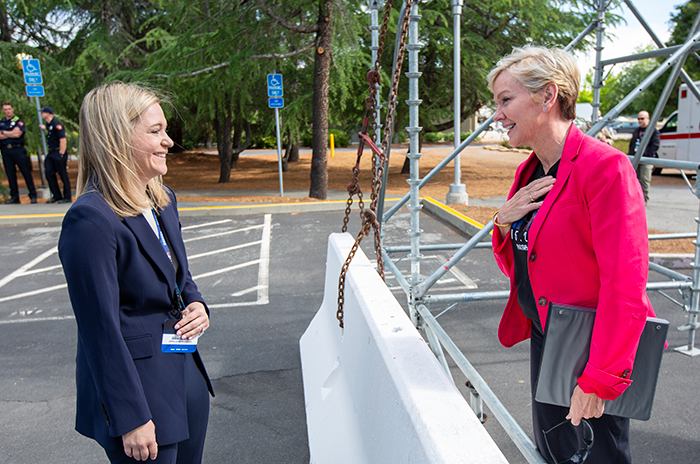 Kritcher chats with U.S. Energy Secretary Jennifer M. Granholm during an ignition celebration at LLNL in May 2023. Credit: Jason Laurea
Kritcher chats with U.S. Energy Secretary Jennifer M. Granholm during an ignition celebration at LLNL in May 2023. Credit: Jason Laurea Kritcher, a native of Traverse City, Michigan, says she began finding her footing in science toward the end of high school “when I figured out that I was good at math. I enjoyed it and it made sense to me. Once I started doing more math and physics, I felt like I was speaking my own language.”
She gravitated toward a group of friends who were interested in physics and engineering. “It was the first time I felt like, well, this is clicking, and I must do something along these lines,” she says.
When she enrolled at Michigan, she discovered the nuclear engineering department and studied radiological sciences and plasma physics. She was headed to a career using radio isotopes to cure cancer—yet another grand scientific challenge.
But a different path opened the summer before her senior year when Kritcher came to LLNL as a summer intern and began working on laser-based experiments. “It was so much fun, that really was the tipping point for me,” she says.
She attended different seminars to learn more about what the Lab did, but still planned on going back to Ann Arbor to pursue either nuclear physics or radiological engineering. Once she saw NIF, she was impressed by “the scale of the facility and the people who are involved, the mission of the facility, and the fact that it’s really big science,” she says. “Otherwise, I might have stayed in nuclear physics or radiological engineering.”
She was also intrigued by the resources the Lab offers.
“Solving problems, using math to do it, running these awesome computer simulations that we have entire teams developing, and then being able to influence how these massive projects can go, I just thought it was really interesting,” she says.
Former LLNL plasma physics group leader Siegfried Glenzer, who led some of the first ICF shots at NIF, was an early mentor of Kritcher at the Lab.
“From the beginning, I was impressed by Andrea’s attention to detail and her ability to work through very challenging technical issues,” says Glenzer, who is now a professor and high energy density division director at the SLAC National Accelerator Laboratory in Menlo Park, California.
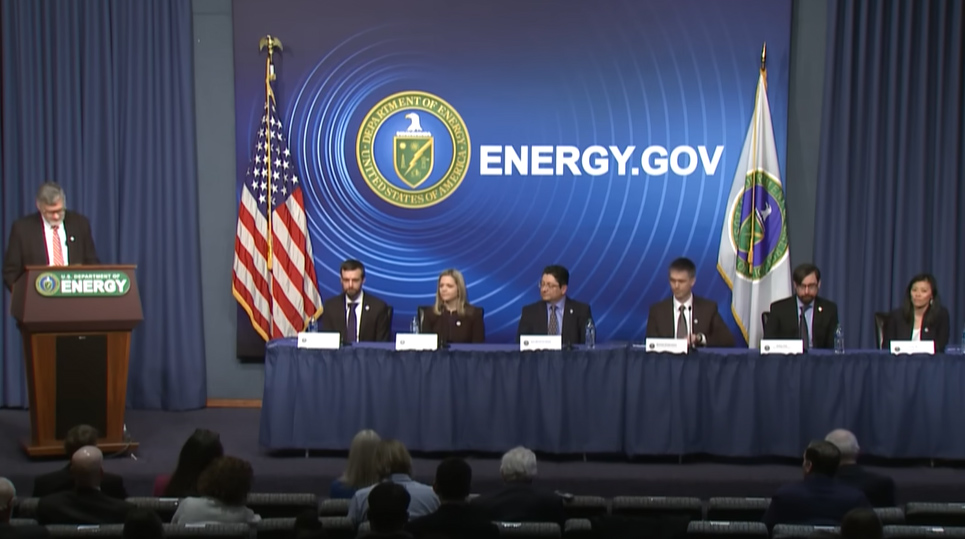 Kritcher (third from left) served on a panel of NIF scientists who talked about the Dec. 5, 2022, fusion ignition experiment following a Dec. 13, 2022, news conference in Washington D.C. Program Director for Weapon Physics and Design Mark Herrmann, left, moderated the post-press conference panel, which included Alex Zylstra, Jean-Michel Di Nicola, Michael Stadermann, Arthur Pak, and Tammy Ma. Credit: DOE
Kritcher (third from left) served on a panel of NIF scientists who talked about the Dec. 5, 2022, fusion ignition experiment following a Dec. 13, 2022, news conference in Washington D.C. Program Director for Weapon Physics and Design Mark Herrmann, left, moderated the post-press conference panel, which included Alex Zylstra, Jean-Michel Di Nicola, Michael Stadermann, Arthur Pak, and Tammy Ma. Credit: DOE Kritcher returned to Michigan to earn a B.S. in nuclear engineering and radiological sciences. She then came back to the West Coast to earn a Ph.D. and M.S. in nuclear engineering from the University of California, Berkeley. She competed her thesis work through the Lab, learning from her work at the Jupiter Laser Facility’s Janus laser. She became a Lawrence postdoc scholar in 2009 before transitioning to become a member of the Lab’s technical staff in 2012.
“When she joined the ICF design team,” Glenzer says, “it was quite obvious that Andrea was ready to take on the biggest challenges and make critical contributions towards ignition on the NIF. I am very happy for the team and to have witnessed Andrea's contributions to this great success.
“It was a real pleasure to present new ideas to Andrea, let her develop a course of action, and then together challenge every step of the way until we got it perfect,” Glenzer says. “Every project resulted in papers in high-impact scientific journals.”
Edward Morse, who recently retired as a UC Berkeley professor of nuclear engineering, noted that Kritcher turned in “one of two theses in my lifetime that were published in Science in the same week that I signed the thesis.”
As an Illinois native, Morse instantly appreciated Kritcher’s Midwestern style. “She was a real straight shooter and has a great sense of humor, very dry,” he says. “She had that kind of Midwestern knack for resilience.”
Getting to fusion ignition, for example, “was not easy, but she’s the kind of person who hangs in there, does what she needs to do, and meanwhile, has raised three kids,” Morse says. “She’s not taking any easy paths, but she’s got everything under control.”
Kritcher credits the Lab for being “really instrumental” in helping her maintain a work-life balance with flexible schedules. When Kritcher was expecting her first daughter nine years ago, she requested a modified 80 percent work week, with teleworking on Thursday—a relatively new idea at the time—and Fridays off.
With the strong support of Callahan, Kritcher was able to work on that schedule without losing productivity. Since then, she had two children, a son and another daughter, now ages 7 and 4.
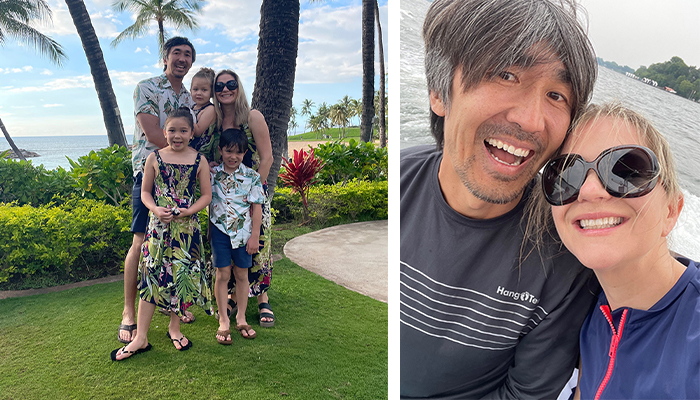 Kritcher enjoys family time with her husband, Ying Wu, two daughters, and son. Credit: Pam Kritcher and Annie Kritcher
Kritcher enjoys family time with her husband, Ying Wu, two daughters, and son. Credit: Pam Kritcher and Annie Kritcher “It’s a really big deal to have that kind of work-life flexibility,” Kritcher says. “In looking back, it is what kept me at the Lab. Especially when you’re talking about young women staying in science and engineering, a lot of people leave the workforce when they have kids because it’s a really hard emotional thing to navigate. When there is flexibility and you can work with your institution to figure out what works for you, it makes such a big difference.”
At the same time, she also became a principal designer of the ICF team that kept inching closer to its goal—achieving a burning plasma condition on Aug. 8, 2021, that ultimately led to ignition in December 2022.
And just as NIF experiments were starting to achieve the burning plasma regime for the first time, the COVID-19 pandemic enveloped the world and piled on even more challenges for Kritcher and her husband Ying Wu, who works in the semiconductor industry.
“At that time, I had a baby under 1 and two really young kids, and we were doing school from home,” Kritcher says. “I have a really supportive husband, so we did a lot of shifting around of schedules. He would do a night shift and I would do the day shift, or flip-flop. We made it work and now things are a lot more calm.”
Kritcher likes to relax by running. “I’ll take a half-hour and just do that myself,” she says.
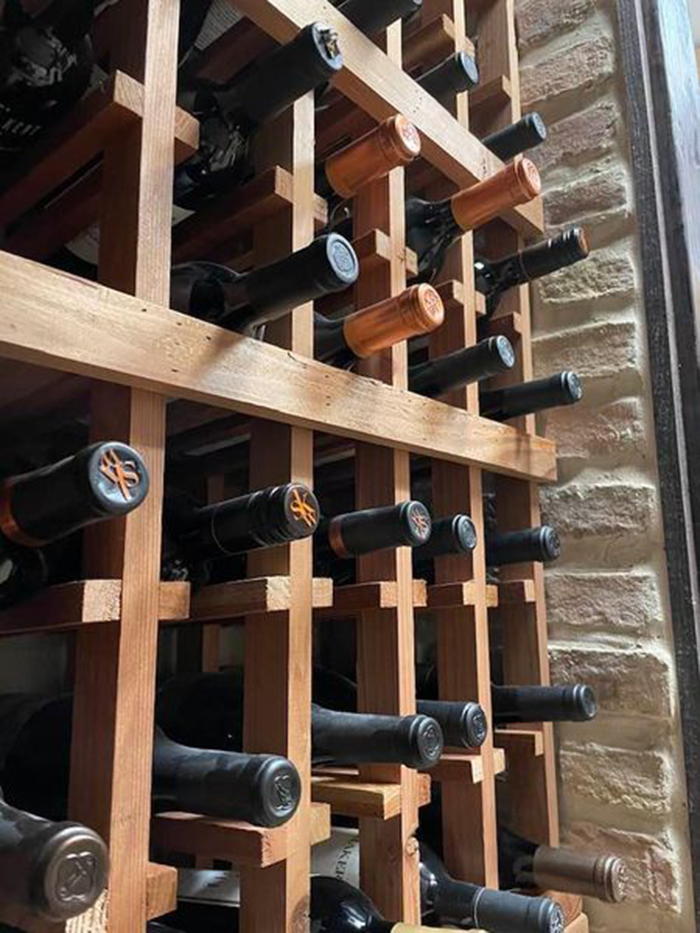
She also has picked up woodworking as a hobby and built a wine cellar under the staircase. That tapped into her design skills, but with different materials such as wood, brick, grout, drywall, and tile. “It’s a good release of energy and frustration,” she says.
And she enjoys painting with a palette knife and has hung some abstracts around her house. “I’m not going to sell my paintings, but it’s fun,” she says.
At work, Kritcher was one of two LLNL physicists selected as 2022 fellows of the American Physical Society (APS) for her “leadership in integrated hohlraum design physics.” And she was part of the LLNL Burning Plasma Team that won the 2022 APS John Dawson Award for Excellence in Plasma Physics Research.
In 2023, she was part of an ignition team of nearly 250 people that was honored with an LLNL Director’s Science & Technology Award. And on Feb. 20, 2024, she and the entire ignition team were honored with a Department of Energy Achievement Award, the department’s highest form of employee recognition.
And although the year-plus following ignition became quite an unusual whirlwind, Kritcher says she keeps her focus on the current challenges of designing and refining experiments that enhance and explore the possibilities LLNL’s achievement opened.
“We fill our days easily with trying to analyze exactly what happened and all of the data that we have and try to look at new ways to improve things,” she says. “So there’s never a dull moment.”
She’s taken on the role of mentoring some of the younger members of her staff and tries to remind them not to get discouraged when experimental results don’t immediately come in as expected.
“It’s about the longer game, so I try to encourage the people that are working on my team on different designs,” she says. “I do try to convey the fact that it is still an R&D effort and it’s not just one-and-done, robust forever. It requires understanding to make our experiments robust and to make continual improvements.”
That’s just the way science works—it’s a continuous challenge.
More Information:
“The Age of Ignition: A NIF & Photon Science News Special Report”
“LLNL’s Breakthrough Ignition Experiment Highlighted in Physical Review Letters,” NIF & Photon Science News, February 5, 2024
“Dan Casey: Applying Ignition’s Lessons to Inertial Fusion Energy,” NIF & Photon Science News, January 10, 2024
“LLNL Experimental Physicist Awarded 2023 Fabre Prize,” NIF & Photon Science News, October 4, 2023
“NIF’s Jeff Wisoff and Jean-Michel Di Nicola Elected Optica Fellows,” NIF & Photon Science News, October 4, 2023
“Physicist Otto “Nino” Landen Receives Prestigious Edward Teller Award,” NIF & Photon Science News, October 4, 2023
“Meet the People Behind the Scenes of LLNL’s Historic Ignition Shot,” NIF & Photon Science News, August 2, 2023
“For Tammy Ma, Paying It Forward Has Paid Career Dividends,” NIF & Photon Science News, July 12, 2023
—Benny Evangelista
Follow us on Twitter: @lasers_llnl



